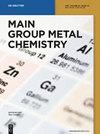Study of solvent effect on structural and photoconductive behavior of ternary chalcogenides InBiS3-In2S3-Bi2S3 composite thin films deposited via AACVD
IF 1.2
3区 化学
Q3 CHEMISTRY, INORGANIC & NUCLEAR
引用次数: 13
Abstract
Abstract In the present work ternary composite InBiS3-In2S3-Bi2S3 (IBS) thin films are developed using a homogeneous mixture of precursors [Bi(S2CN(C2H5)2)3]2 (1) and [In(S2CNCy2)3]‧2py (2), separately in toluene and chloroform solutions at 500°C under an inert atmosphere of argon gas via aerosol assisted chemical vapor deposition (AACVD) technique. The phase purity, chemical composition and morphological study of both the films deposited from toluene and chloroform solutions are characterized by X-ray diffraction (XRD), X-ray photoelectron spectroscopy (XPS), Raman spectroscopy and Field emission scanning electron microscopy (FESEM). The surface morphology showed rod like structure of the films developed from toluene while the films grown from chloroform solution give flake like shapes. The UV-visible spectroscopy explicated that the thin films developed from toluene and chloroform solutions show wide range absorption in whole visible region. Linear Scan voltammetry results show that both the films give negligible dark current, however, the films fabricated from toluene solution give a sharp steep curve with maximum photocurrent density of 2.3 mA‧cm-2 at 0.75 V vs Ag/AgCl/3M KCl using 0.05 M sodium sulphide solution under AM 1.5 G illumination (100 mW‧cm-2), while the film grown from chloroform generates a photocurrent density of 2.1 mA‧cm-2 under similar conditions. The LSV outcomes are further supported by electrochemical impedance spectroscopy (EIS) that gives charge transfer resistance (Rct) value of 8,571 Ω for the films developed from toluene as compared to films fabricated from chloroform with Rct value of 12,476 Ω. Graphical Abstract溶剂对AACVD沉积三元硫族化合物InBiS3-In2S3-Bi2S3复合薄膜结构和光电导行为的影响研究
摘要本文采用气溶胶辅助化学气相沉积(AACVD)技术,将前驱体[Bi(S2CN(C2H5)2)3]2(1)和[In(S2CNCy2)3] 2py(2)的均匀混合物分别置于500°C的甲苯和氯仿溶液中,在惰性氩气气氛下制备了三元复合材料InBiS3-In2S3-Bi2S3 (IBS)薄膜。采用x射线衍射(XRD)、x射线光电子能谱(XPS)、拉曼光谱(Raman spectroscopy)和场发射扫描电镜(FESEM)对甲苯和氯仿溶液制备的膜的相纯度、化学成分和形貌进行了表征。在甲苯溶液中生长的膜表面形貌为棒状,而在氯仿溶液中生长的膜表面形貌为片状。紫外可见光谱分析表明,由甲苯和氯仿溶液制备的薄膜在整个可见光区都有较宽的吸收范围。线性扫描伏安法结果表明,两种薄膜的暗电流均可忽略,但在0.75 V vs Ag/AgCl/3M KCl下,在0.05 M硫化钠溶液下,在AM 1.5 G照明(100 mW·cm-2)下,甲苯溶液制备的薄膜曲线陡峭,最大光电流密度为2.3 mA·cm-2,而氯仿生长的薄膜在相同条件下产生的光电流密度为2.1 mA·cm-2。电化学阻抗谱(EIS)进一步支持了LSV结果,甲苯制备的膜的电荷转移电阻(Rct)值为8,571 Ω,而氯仿制备的膜的Rct值为12,476 Ω。图形抽象
本文章由计算机程序翻译,如有差异,请以英文原文为准。
求助全文
约1分钟内获得全文
求助全文
来源期刊

Main Group Metal Chemistry
CHEMISTRY, INORGANIC & NUCLEAR-CHEMISTRY, ORGANIC
CiteScore
4.10
自引率
27.80%
发文量
21
审稿时长
4 weeks
期刊介绍:
This journal is committed to the publication of short communications, original research, and review articles within the field of main group metal and semi-metal chemistry, Main Group Metal Chemistry is an open-access, peer-reviewed journal that publishes in ongoing way. Papers addressing the theoretical, spectroscopic, mechanistic and synthetic aspects of inorganic, coordination and organometallic main group metal and semi-metal compounds, including zinc, cadmium and mercury are welcome. The journal also publishes studies relating to environmental aspects of these metals, their toxicology, release pathways and fate. Articles on the applications of main group metal chemistry, including in the fields of polymer chemistry, agriculture, electronics and catalysis, are also accepted.
 求助内容:
求助内容: 应助结果提醒方式:
应助结果提醒方式:


